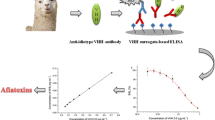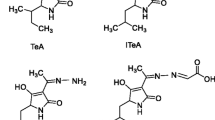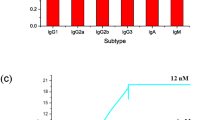Abstract
An improved enzyme-linked immunosorbent assay (ELISA) combined with monoclonal antibody (MAb) and one-step extraction method was established for the estimation of aflatoxin B1 (AFB1) in a peanut product. AFB1 was converted to AFB1-oxime, and then conjugated with bovine serum albumin (BSA). Spleen cells from mice immunized with AFB1-BSA conjugates were fused with myeloma cells. After double selection with AFB1-ovalbumin (OVA) and carbodiimide-modified OVA, five stable hybridoma cells secreting anti-AFB1 MAbs (AF1, AF 2, AF 3, AF 4, and AF5) were cloned. Using these anti-AFB1 MAbs, we developed the indirect competitive ELISA (cELISA) with alkaline phosphatase (ALP) — labeled sheep anti — mouse IgG as marker and the direct cELISA with AFBi-oxime horseradish peroxidase (POD) as marker.
The minimum detectable limits of the indirect cELISA with AF 1, 2, 3, 4, and 5 were 5, 5, 5, 5, and 50 pg of standard AFB1 per assay, respectively, and those of the direct cELISA with AF 1, 3, 4, and 5 were 2.5, 5, 25, and 100 pg of standard AFB1 per assay, respectively. The cross reactivity of each toxins with these MAbs in the indirect cELISA was as follows: (a) AF 1 and AF 2 were reactive with AFB2 as well as AFB1, weakly with AFG2 > AFG1 > aflatoxicol II (COL II) > aflatoxicol I (COL I) and less weakly with other aflatoxins; (b) AF 3 and AF 4 were reactive with COL II as well as AFB1, weakly with COLI > AFQ1 and less weakly with others; (c) AF 5 was AFQ1 as well as AFB1 weakly with COL II > AFG2 > COL I and less weakly with others.
The 60% aqueous methanol extracts of oil-roasted blanched peanuts (“butter peanut”), naturally contaminated with AFB1, were assayed by the direct cELISA without further purification. The direct cELISA with the most sensitive MAb AF 1 was allowed to determine 1 ng of AFB1 per g samples.
Similar content being viewed by others
References
Heathcote JG (1984) Aflatoxins and related toxins, pp 89–132.In: V Betina (ed), Mycotoxins, Elsevier, Amsterdam
Plamgren MS and Hayes AW (1987) Aflatoxins in food, pp 65 -95.In: P Krogh (ed), Mycotoxins in Food, Academic Press, London
3 van Rensburg SJ, Cook-Mozaffan P, van Schalkwyk DJ, van der Watt JJ, Vincent TJ, and Purchase IF (1985) Hepatocellular carcinoma and dietary aflatoxin in Mozambique and Transkei. Br J Cancer 51:713–726
Sun T, Wu Y, and Wu S (1983) Monoclonal antibody against aflatoxin B1 and its applications. Clin J Oncol 5:401–405
Bulatao-Jayme J, Almero EM, Castro MCA, Jardeleza MT, and Salamat LA (1982) A case-control dietary study of primary liver cancer risk from aflatoxin exposure. Int J Epidemiol 11 (2): 112–119
Stoloff L (1983) Aflatoxin as a cause of primary liver-cell cancer in the United States: a probability study. Nutr & Cancer 5:165–186
World Health Organization (1985) Prevention of Liver Cancer, WHO Technical Report Ser 691, Geneva
Ueno Y (1987) Mycotoxins, pp 139–204.In: K Miller (ed) Toxicological Aspects of Food, Elsevier, Amsterdam
McMahon G, Hanson L, Lee JJ, and Wogan GN (1986) Identification of an activated c-Ki-ras oncogene in rat liver tumors induced by aflatoxin B1. Proc Natl Acad Sci USA 83:9418–9422
McMahon G, Davis E, and Wogan GN (1987) Characterization of c-Ki-ras oncogenes alleles by direct sequencing of enzymatically amplified DNA from carcinogen-induced tumors. Proc Natl Acad Sci USA 84:4974–4978
Tashiro F, Morimura S, Hayashi K, Makino R, Kawamura H, Horikoshi N, Nemoto K, Ohtsubo K, Sugimura T, and Ueno Y (1986) Expression of thec-Ha-ras andc-myc genes in aflatoxin B1-induced hepatocellular carcinoma. Biochem Biophys Res Comm 138:858–864
Chu FS and Ueno I (1977) Production of antibodies against aflatoxin B1. Appl Environ Microbiol 33:1125–1128
Chu FS, Hsia MTS, and Sun PS (1977) Production of antibodies against aflatoxin B1 for enzyme-linked immunosorbent assay. J Assoc Off Anal Chem 60:791–794
El-Nakib, Pestka JJ, and Chu FS (1981) Determination of aflatoxin B1 in corn, wheat, and peanut butter by enzyme-linked immunosorbent assay and solid phase radioimmunoassay. J Assoc Off Anal Chem 64:1077–1082
Ram BP and Hart LP (1986) Enzyme-linked immunosorbent assay of aflatoxin in naturally contaminated corn and cottonseed. J Assoc Off Anal Chem 69: 904–907
Wild CP, Umbenhauer D, Chpot B, and Montesano R (1986) Monitoring of individual human exposure to aflatoxins (AF) and N-nitrosamines (NNO) by immunoassay. J Cell Biochem 30:171–179
Pestka JJ, Li YK, and Chu FS (1982) Reactivity of aflatoxin B2a antibody with aflatoxin B1-modified DNA and related metabolites. Appl Environ Microbiol 44:1159–1165
Groopman JD, Trubel LJ, Donahue PR, Marshak-Rothstien A, and Wogan GN (1985) High affinity monoclonal antibodies for aflatoxins and their application to solid-phase immunoassays. Proc Natl Acad Sci USA 81:7728–7731
Hertzog PJ, Shaw A, Smith L Jr, and Garner RC (1983) Improved conditions for the production of monoclonal antibodies to carcinogen-modified DNA, for use in enzyme-linked immunosorbent assays (ELISA). J Immunol Meth 62: 49–58
Köhler G and Milstein C (1975) Continuous cultures of fused cells producing antibody of predefined specificity. Nature (London) 256:495–497
Oi VT and Herzenburg LA (1980) Immunoglobulin-producing hybrid cell lines, pp 351–371. In: BB Mishell and SW Shiigi (eds) Selected Methods in Cellular Immunology. WH Freeman & Co, San Francisco
Pestka JJ, Gaur PK, and Chu FS (1980) Quantitation of aflatoxin B1 and aflatoxin B1antibody by an enzyme-linked immunosorbent microassay. Appl Environ Microbiol 40:1027–1031
Ishibashi E (1982) The methods of labeling enzyme to the low molecular substances in enzyme immunoassay, pp 128–138. In: E Ishibashi, T Kawai, and K Miyai (eds) Enzyme Immunoassay, Igakushoin, Tokyo (in Japanese)
Candlish AAG, Stimson WH, and Smith JE (1985) A monoclonal antibody to aflatoxin B1: detection of the mycotoxin by enzyme immunoassay. Lett Appl Microbiol 1:57–61
Dragsted LO, Bull I, and Autrup H (1988) Substance with affinity to a monoclonal aflatoxin B1 antibody in Danish urine samples. Fd Chem Toxicol 26: 232–242
Whitaker TB, Dickens JW, and Giesbrecht FG (1984) Effect of methanol concentration and solvent: peanut ratio on extraction of aflatoxin from raw peanut. J Assoc Off Anal Chem 67:35–36
Whitaker TB and Dickens JW (1986) Optimal methanol concentration and solvent / peanut ratio for extraction of aflatoxin from raw peanuts by modified AOAC method II. J Assoc Off Anal Chem 69:508–810
Author information
Authors and Affiliations
Rights and permissions
About this article
Cite this article
Kawamura, O., Nagayama, S., Sato, S. et al. A monoclonal antibody-based enzyme-linked immunosorbent assay of aflatoxin B1 in peanut products. Mycotox Res 4, 75–88 (1988). https://doi.org/10.1007/BF03192102
Received:
Accepted:
Issue Date:
DOI: https://doi.org/10.1007/BF03192102




